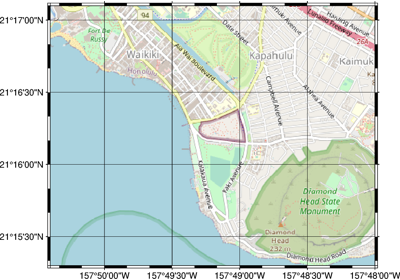pygmt.Figure.tilemap
- Figure.tilemap(region, zoom='auto', source=None, lonlat=True, wait=0, max_retries=2, *, frame=None, dpi=None, shading=None, projection=None, monochrome=None, no_clip=None, nan_transparent=None, verbose=None, panel=None, perspective=None, transparency=None, **kwargs)
Plots an XYZ tile map.
This method loads XYZ tile maps from a tile server or local file using
pygmt.datasets.load_tile_mapinto a georeferenced form, and plots the tiles as a basemap or overlay usingpygmt.Figure.grdimage.Note: By default, standard web map tiles served in a Spherical Mercator (EPSG:3857) Cartesian format will be reprojected to a geographic coordinate reference system (OGC:WGS84) and plotted with longitude/latitude bounds when
lonlat=True. If reprojection is not desired, please setlonlat=Falseand provide Spherical Mercator (EPSG:3857) coordinates to theregionparameter.Aliases:
B = frame
E = dpi
I = shading
J = projection
M = monochrome
N = no_clip
Q = nan_transparent
V = verbose
c = panel
p = perspective
t = transparency
- Parameters
region (list) – The bounding box of the map in the form of a list [xmin, xmax, ymin, ymax]. These coordinates should be in longitude/latitude if
lonlat=Trueor Spherical Mercator (EPSG:3857) iflonlat=False.Optional. Level of detail. Higher levels (e.g.
22) mean a zoom level closer to the Earth’s surface, with more tiles covering a smaller geographical area and thus more detail. Lower levels (e.g.0) mean a zoom level further from the Earth’s surface, with less tiles covering a larger geographical area and thus less detail [Default is"auto"to automatically determine the zoom level based on the bounding box region extent].Note: The maximum possible zoom level may be smaller than
22, and depends on what is supported by the chosen web tile provider source.source (xyzservices.TileProvider or str) –
Optional. The tile source: web tile provider or path to a local file. Provide either:
A web tile provider in the form of a
xyzservices.TileProviderobject. See Contextily providers for a list of tile providers [Default isxyzservices.providers.Stamen.Terrain, i.e. Stamen Terrain web tiles].A web tile provider in the form of a URL. The placeholders for the XYZ in the URL need to be {x}, {y}, {z}, respectively. E.g.
https://{s}.tile.openstreetmap.org/{z}/{x}/{y}.png.A local file path. The file is read with rasterio and all bands are loaded into the basemap. See Working with local files.
IMPORTANT: Tiles are assumed to be in the Spherical Mercator projection (EPSG:3857).
lonlat (bool) – Optional. If
False, coordinates inregionare assumed to be Spherical Mercator as opposed to longitude/latitude [Default isTrue].wait (int) – Optional. If the tile API is rate-limited, the number of seconds to wait between a failed request and the next try [Default is
0].max_retries (int) – Optional. Total number of rejected requests allowed before contextily will stop trying to fetch more tiles from a rate-limited API [Default is
2].kwargs (dict) – Extra keyword arguments to pass to
pygmt.Figure.grdimage.
- Raises
ImportError – If
rioxarrayis not installed. Follow install instructions for rioxarray, (e.g. viapython -m pip install rioxarray) before using this function.
